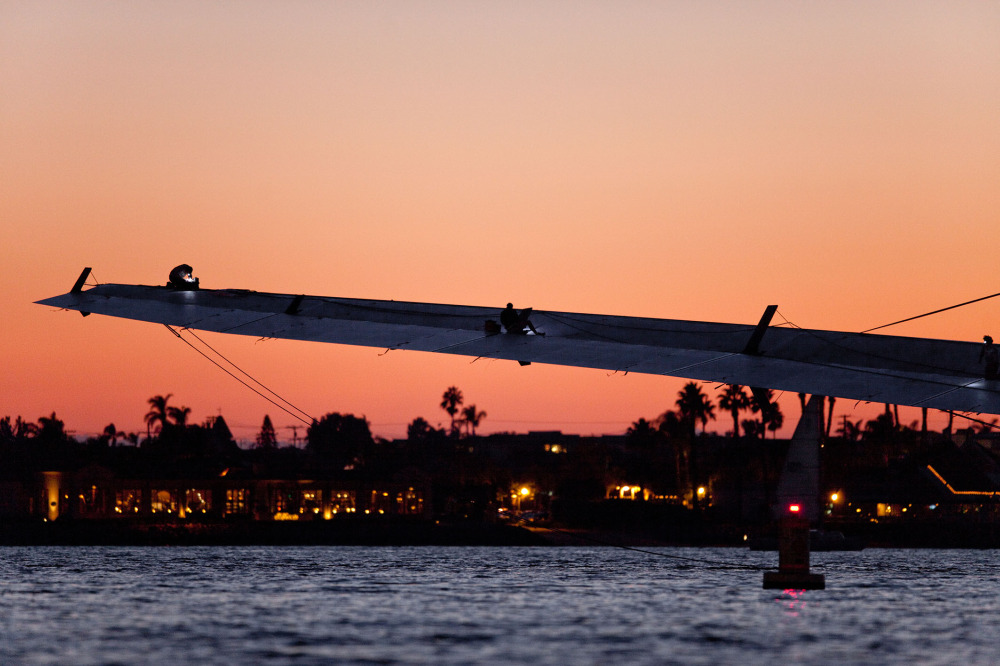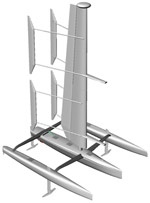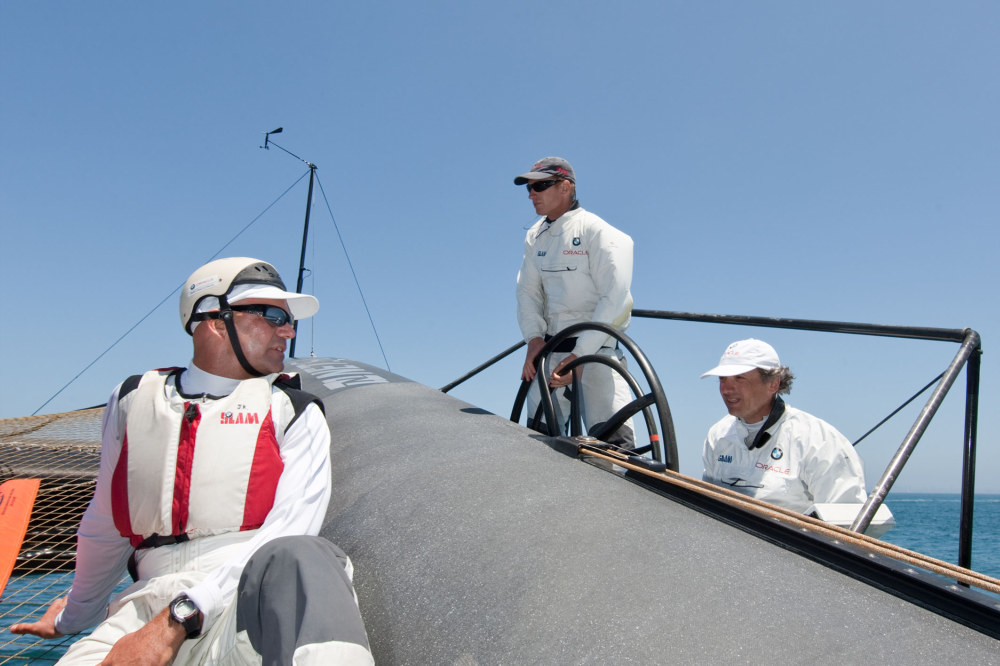FutureSailing – Mike Drummond.2
Part 4.2 of a series of conversations with people who are driving profound changes in the way that we are able to sail. Once the opportunities are clear, how will people choose to sail?
Mike Drummond, BMW Oracle Racing’s design director, allows as how the wing on the BMOR trimaran can generate negative lift “on paper.”
Negative Lift is what you get from a vertically-sectioned wing, using a lower portion to drive the boat forward (also generating sideways and heeling forces) while a contra-shaped upper portion counters that force, lifting the boat back toward its upside.
 The wing lowered before the boat was shipped from California. Click to enlarge. Photo by Gilles Martin-Raget/BMOR
The wing lowered before the boat was shipped from California. Click to enlarge. Photo by Gilles Martin-Raget/BMOR
Before we hear more from Drummond, let’s have a take from Mark Ott on negative lift. Ott is the director, etcetera, of the Harbor Wing project aimed at automating wings for ocean-going craft, and he’s itching to do a performance cruising multihull or, better yet, an ocean-records boat. He spends day and night thinking about wings, he shares design team members with BMOR, and he had this to say:
“The BMOR wing can produce negative lift by moving the upper flaps in a reverse direction, but because their leading structural wing section is a single unit from bottom to top, this produces a proportionately small effect and creates drag. This is, however, a simple way for them to affect heeling moments.
“The BMOR engineers needed to come up with a wing in a hurry, one that was quick to build and produced gobs of lift as simply as possible. My guess is that if the next Cup was raced in, say, a box rule of 60×60 to keep the costs down, you would see a more sophisticated group of multihulls with wing sails and the BMOR wing would look quaint in that company.”
The practicality and utility of negative lift are good for debate in any gathering of engineers. Might negative lift induce so much drag that you wouldn’t use it for speed to weather, but rather crank it up to reduce power for a hairy mark turn in a breeze?
And if it works say, Hallelujah!
Returning now to Mike Drummond—and note that I am mixing bits of separate conversations and Mike was making his own comment, not responding to Ott—the BMOR design director said, “We’re not waving our hands in the air, shouting what a new thing we’ve done. Not much is really new. The notion of wings on boats probably dates to the aviation boom of the 1920s—I’m no historian—and more recently it came into its own on C-Class cats. All we’ve done is apply common sense and modern methods. The experience is mostly about the frightening scale of the project.”
Meaning a wing 190 feet high, almost identical to the total wingspan of a Boeing 747 (two wings and a fuselage). Yes, the boat could sail under the Golden Gate Bridge, with an inkie-winkie to spare.
 For comparison, here’s Ott again, “In our Harbor Wing design we have installed load cells at the base of the stub mast in the x axis and the y axis. The processor reads the heeling moment in 10htz real time as well as pounds/thrust and the resultant thrust vector. In this way we automatically and precisely control our angle of heel by reducing power instantly when necessary. I spent time studying the Harbor Wing X-1 [a 30-foot prototype] in 30 knots of disturbed wind at the dock with the wing parked in neutral. What I saw was the top of the wing creating lift in a direction opposite to the lift of the bottom section; the wing was fighting itself to resolve the opposing forces. David Hubbard and I put our heads together and decided that the best way to prevent this unwanted action was to allow the top leading and trailing sections to independently rotate free of the bottom section by 90 degrees. This will allow us to turn off or completely feather the top in a hard blow, effectively reefing the wing, much as any sailor would reef a soft sail. It will also allow us to change the angle of attack of the entire top airfoil assembly (including leading edge) and therefore mimic the twist of a well-designed soft sail to compensate for wind gradient or, in more extreme cases, wind shear. This design translates into more power when you want it and no power when you don’t, and it accomplishes this without producing drag.”
For comparison, here’s Ott again, “In our Harbor Wing design we have installed load cells at the base of the stub mast in the x axis and the y axis. The processor reads the heeling moment in 10htz real time as well as pounds/thrust and the resultant thrust vector. In this way we automatically and precisely control our angle of heel by reducing power instantly when necessary. I spent time studying the Harbor Wing X-1 [a 30-foot prototype] in 30 knots of disturbed wind at the dock with the wing parked in neutral. What I saw was the top of the wing creating lift in a direction opposite to the lift of the bottom section; the wing was fighting itself to resolve the opposing forces. David Hubbard and I put our heads together and decided that the best way to prevent this unwanted action was to allow the top leading and trailing sections to independently rotate free of the bottom section by 90 degrees. This will allow us to turn off or completely feather the top in a hard blow, effectively reefing the wing, much as any sailor would reef a soft sail. It will also allow us to change the angle of attack of the entire top airfoil assembly (including leading edge) and therefore mimic the twist of a well-designed soft sail to compensate for wind gradient or, in more extreme cases, wind shear. This design translates into more power when you want it and no power when you don’t, and it accomplishes this without producing drag.”
Data sensors are critical to both Harbor Wing and BMOR. Larry Ellison’s giant tri has sensors taking pressure readings at 26,000 data points per second. Can Unit G take more load? Is Unit R on the edge of failure? The team claims that in failures during the work-up in San Diego, the multi-element nature of the wing proved invaluable. That is, stuff broke but never the whole thing. So yes, the wing is the challenger setup for AC 33. But, as backup, it was a no-brainer to load the soft-sail rigs onto the ship that carried boat and wing to Valencia.
 John Kostecki, tactician, foreground, with James Spithill at the wheel.
John Kostecki, tactician, foreground, with James Spithill at the wheel.
Photo by Gilles Martin-Raget/BMOR
And as for that wing, well, it’s a small design world, with fewer than six degrees of separation. Part of the BMOR design team (naturally, would they leave a stone unturned?) is David Hubbard, the same David Hubbard that Mark Ott mentioned above, who also is part of the team at Harbor Wing, which gives his bio thus: Mr. Hubbard developed the first slotted full airfoil airplane style wing for a sail craft in 1965 and won the Little America’s Cup four times with its evolution. In 1982, his Red Herring became the world’s first modern version of the canting keel, and in 1988 he designed and built the wing sail for Dennis Conner’s winning America’s Cup catamaran, Stars & Stripes.
For the BMOR wing, Drummond says, “I think we’ve done a good job of figuring out the three-dimensional pressure interactions. Even if we did it again tomorrow we wouldn’t change much. So far the team’s predictions have been bloody good. Most of what we’ve tested has scaled up well, and where the numbers didn’t fit, something scaled up in a positive sense.
“Think of the parallels,” Drummond says. “Canting keels were around for a long time as an idea before people started to sail with them. Soft sail rigs? Who knows how many have been built. For wings on boats, I bet the worldwide count is fewer than 100.”
It takes an authentic wing geek to be aware of U.S. patent No.3, 332, 383, which arguably solved the camber variables of a wing sail at the mechanical level, but in a time when the available materials would have made the wing prohibitively heavy. Carbon is the key to the hotrod boats of our moment, but not necessarily of the future. “New materials let us improve on old ideas,” Drummond says. “The future comes back to structure. If Nathaniel Herreshoff was around today he probably would produce boats as fast as these. I have to hand it to Herreshoff’s yard, to the people who built Reliance at 143 feet for the 1903 Cup. In many cases they used materials that had not been around very long. Like us, their desire for performance led them to accept a short-term boat.
“With better materials you can take old ideas and improve them. Say there might be a material that hasn’t been invented yet that’s lighter and stronger than carbon; actually, it’s been invented, it’s just not available commercially.”
And that would be?
“That would be M5.”
Dupont describes M5 as, “an ultra-high strength, ultra-high thermal and flame resistant alternative to products currently available in the advanced fibers market.”
OK, the conversations in this series have several times turned on efforts to automate sailing, a subject sure to inspire a few and offend many. Any Mike Drummond thoughts on that?
“Sailing is a continuum, from an Opti with a single sheet to the biggest thing you’ve got. I personally wouldn’t have a powered winch on a sailing yacht. But that’s just me. ”
